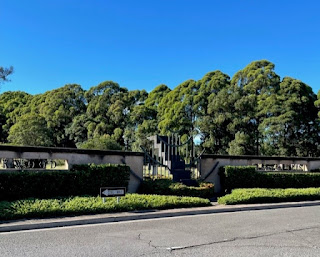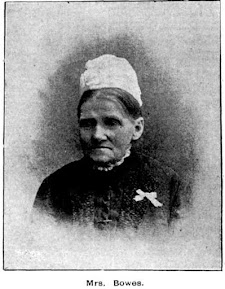The naming of a Cemetery
For my first blog after a
lengthy absence due to travel and health commitments I have chosen not to
highlight a "forgotten" person but to go into detail about the naming
of The Necropolis and its close ties to a London Necropolis in Southern
England.
In my blog's information
page, there are some details about what Rookwood Cemetery Discoveries is all
about. It gives a potted history of the Cemetery and how it came about as well
as how it has evolved over many years.
Rookwood Cemetery Gates (west entrance) built 1993 - Author's collection
What I did not discuss was the naming of Cemetery and its environs and there have been a few!
WHAT IS THE ORIGIN OF THE
NAME "ROOKWOOD"
When it was discovered that
the Devonshire Street Cemetery (which was resumed due to the construction of
Central Train Station in 1900) was not able to house the estimated amount of
the City's dead after the influx of people after gold was discovered in 1851, a
new area was required to be found.
As was the case in Europe,
it was decided to position the new Cemetery away from the city for practical
and health reasons. A new railway line heading to Parramatta had been
established in 1855 and it was decided to locate the Cemetery somewhere along
the line. It had been done successfully a decade prior in England so it was
assumed a similar scheme would work here.
A Committee was set up to
locate a suitable site and the Government purchased 80 hectares of land at
Haslems Creek from the estate of Edward Cohen as it was relatively isolated and
near the rail line.
The Necropolis Act came into
force on 1 January 1868 and the Haslems Creek Cemetery was officially opened
(although there were some burials prior to this date). The railway line
construction began in November 1864 and from January 1867 trains began their
run into the Cemetery with the funeral train stopping at prearranged stations
on the journey from central Sydney in order to pick up mourners and coffins.
A receiving station was
planned for a site on Regent Street Redfern and was completed in March 1869. It
was built in conjunction with the Mortuary No. 1 Station within the cemetery.
Both were designed by James Barnet, Colonial Architect at the time, and cost
£3,000 and £5,000 respectively and designed in a Venetian Gothic style. The
sculptors, Thomas Ducket and Henry Apperly (all three men call the Cemetery
"home"), decorated both buildings in a churchlike manner with angels,
cherubs and gargoyles but they were never used as places of worship.
It wasn't long after the
opening of the Cemetery that the local residents became agitated about living
in a place known specifically for the Necropolis. In 1879 the name of the
cemetery was changed from Haslems Creek to Rookwood.
There are three differing
reasons as to why this name was chosen, the first was that it referred to the
"rook" like birds (crows) that frequented the gardenesque site. The
second was that it was named after a popular novel at the time,
"Rookwood" by Harrison Ainsworth, but the third choice, in my
opinion, was probably why the name was chosen.
“Rookwood”, I believe, is
likely a nod to the name “Brookwood”, at the time one of the largest Cemeteries
in the world serviced by a railway line from central London taking mourners and
coffins directly to it. Brookwood Cemetery was conceived by the London Necropolis
Company in 1849 and officially opened as Brookwood Cemetery; the railway being
built in 1854. It had two Mortuary Stations within its grounds. In the early years,
Rookwood had one station that increased to four with inclusion of three smaller
outposts after 1900 but they didn’t last long.
Both cemeteries have War
Grave areas; Brookwood houses the largest Commonwealth War Graves area in the
United Kingdom. Both Cemeteries have been repositories for monuments and graves
from closed city cemeteries and both cemeteries conduct tours and have active
Friends groups.
I’m of the opinion Rookwood
is named after Brookwood which paved the way for a successful use of the
railway as a means of transport for funerals. Subsequently Rookwood was so
popular that by 1879 a further 233 hectares were purchased.
As you come into Central
Station from the west you will see on your left the striking Receiving Station
which will form part of a new regeneration of the area. It is envisaged the Station
will be surrounded by gardens and the nearby area will open up to a pathway
leading to Redfern, once again the Station will be a focus point!
Brookwood's London terminus
near Waterloo Station was opened in 1854 and operated to the Cemetery until
1902 when it was destroyed to allow expansion of Waterloo Station with a new
terminus opened at Westminster Bridge Road. In April 1941 the building survived
bombing whilst most around it was obliterated but during the following month it
too was bombed sustaining so much incidental damage it was decided to close the
Station permanently. Both the Mortuary Stations remained open as kiosks but fell
into disrepair and the North Station was demolished due to dry rot in the
1960s. The South Station remained open functioning as a storage room and now
houses, after a new building was erected in 2007 following a devasting fire in
1972, resident monks.
Similarly, Rookwood closed in the 1940's, the last train ran in April 1948. Its major internal Mortuary Station was destroyed by fire soon after with the remaining stone building sold off. It now has a new life as an Anglican church in Ainslie Canberra.
The village of Rookwood changed its name to Lidcombe, a combination of two former Mayors names - Lidbury and Larcombe in 1913 and the Cemetery retained the name of Rookwood.
I visited Waterloo recently
and located the old second Brookwood terminus station opposite the graffitied
Leake Station tunnel and couldn't resist taking a few photos and having a closer
“sticky beak”.
Disused London Necropolis 2nd Station 1902-1941 - Authors collection
A closer inspection of the disused London Necropolis 2nd Station - Authors collection
I hope my blog today
explains the close significance between both Cemeteries.
My references today are many; taken mostly from Google, Wikipedia, relevant books and papers on the subjects as well as “The Sleeping City” The story of Rookwood Necropolis edited by David A Weston.
If you have any comments
regarding this blog please add them below or head to the Facebook group page
under
rookwoodcemeterydiscoveries
or send me a personal email
at
lorainepunch@gmail.com
It's Remembrance Day next
week and a suitable blog has been chosen.
Until then













Appreciated reading your blog and look forward to more
ReplyDeleteThere will always be more!
DeleteLove your photos of the London 2nd station Lorraine.
ReplyDeleteIt was put up for sale recently!
Delete